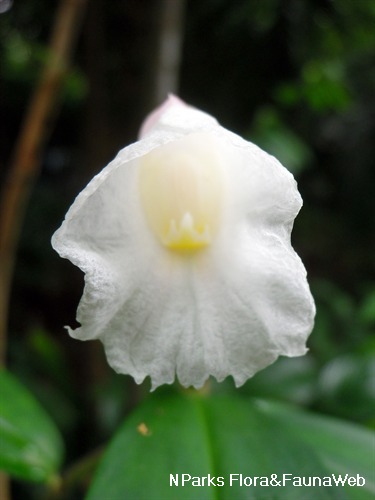
Back
Cheilocostus globosus (Blume) C.D.Specht
| Family Name: | Costaceae |
| Synonyms: | Costus globosus Blume, Costus globosus var. ridleyi (K.Schum.) Holttum |
| Common Name: | Asian Spiral Ginger, Asian Costus, Seta War Hutan (Malay) |
Asian Spiral Ginger (Cheilocostus globosus) is a native species thought to be extinct in Singapore until it was rediscovered in Bukit Timah Nature Reserve in 2012. It is easily propagated through stem cuttings and has been successfully reintroduced into various nature reserves and parks in Singapore. The spirally arranged, glossy leaves and orange, showy flowers make it ideal for landscaping use.
Name
Classifications and Characteristics
| Plant Division | Angiosperms (Flowering Seed Plants) (Monocotyledon) |
|---|---|
| Plant Growth Form | Herbaceous Plant |
| Lifespan (in Singapore) | Perennial |
| Mode of Nutrition | Autotrophic |
| Maximum Height | 1.5 m to 3 m |
Biogeography
| Native Distribution | Singapore, Borneo, Java, Peninsular Malaysia, Sumatra, Thailand |
|---|---|
| Native Habitat | Terrestrial (Freshwater Swamp Forest, Riverine) |
| Preferred Climate Zone | Tropical |
| Local Conservation Status | Native to Singapore (Critically Endangered (CR)) |
Description and Ethnobotany
| Growth Form | Clump-forming herbaceous plant up to 1.5 m tall (3 m in the wild). |
|---|---|
| Foliage | Leaves are oval to oblanceolate (lance-shaped with wider portion near the tip), have a smooth leaf margin and a long pointed tip and (6-18 cm long, 3-6 cm wide). They have little to no leaf stalk, almost directly attached in a spiral arrangement to branches off the main stem. The leaf underside is a lighter shade of green than the upper surface and softly hairy. |
| Stems | Shoots emerge from an underground horizontal stem known as a rhizome. The erect main stem is about 2 cm wide, while branches off the stem are 0.6 cm wide. |
| Flowers | Yellow-orange or orange-red, tubular flowers are produced in an 4-8 cm long, round inflorescence. The inflorescence is attached to a 5-12 cm long, leafless stalk and located near the base of the plant. |
| Fruit | The capsule fruit breaks open at maturity to release black seeds surrounded by white tissue. |
| Habitat | It occurs in wet forests, swamps, and along streams at 1,200 m above sea level. |
| Cultivation | This fast-growing species grows best in moist, well-drained, loamy soil and does not tolerate waterlogging. It is easily propagated by stem cuttings from branches or division. It can be grown in containers filled with loamy soil and 30% sand or perlite. It could be grown indoors but it prefers a humid environment. |
| Etymology | The specific epithet 'globosus' means globose and refers to the round shape of the inflorescence. |
Landscaping Features
| Desirable Plant Features | Ornamental Flowers, Ornamental Foliage |
|---|---|
| Landscape Uses | Parks & Gardens, Small Gardens, Container Planting |
| Thematic Landscaping | Marsh Garden |
Fauna, Pollination and Dispersal
| Pollination Method(s) | Biotic (Fauna) |
|---|
Plant Care and Propagation
| Light Preference | Semi-Shade |
|---|---|
| Water Preference | Lots of Water, Moderate Water, Occasional Misting |
| Plant Growth Rate | Fast |
| Rootzone Tolerance | Moist Soils, Fertile Loamy Soils, Well-Drained Soils |
| Pest(s) | Chewing Insects, Sucking Insects |
| Propagation Method | Stem Cutting (Herbaceous), Seed, Division |
| Propagation Ease | Easy |
Foliar
| Foliage Retention | Evergreen |
|---|---|
| Mature Foliage Colour(s) | Green |
| Foliar Type | Simple / Unifoliate |
| Foliar Arrangement Along Stem | Spiral |
| Foliar Attachment to Stem | Sessile |
| Foliar Shape(s) | |
| Foliar Venation | Pinnate / Net |
| Foliar Margin | Entire |
| Foliar Apex - Tip | Caudate |
| Foliar Base | Cuneate |
| Typical Foliar Area | Mesophyll ( 45cm2 - 182.25 cm2 ) |
| Leaf Area Index (LAI) for Green Plot Ratio | 3.5 (Shrub & Groundcover - Monocot) |
| Typical Foliar Size | 6 cm to 18 cm |
Floral (Angiosperm)
| Flower & Plant Sexuality | Bisexual Flowers |
| Flower Colour(s) | Orange, Red, Yellow / Golden |
|---|---|
| Flower Texture(s) | Thin, Velvety / Furry / Tomentose |
| Flower Grouping | Cluster / Inflorescence |
| Flower Symmetry | Bilateral |
| Individual Flower Shape | Tubular |
| Flowering Period | Free-Flowering |
| Flower Size | 6 cm x 6 cm |
Fruit, Seed and Spore
| Fruit Classification | Simple Fruit |
|---|---|
| Fruit Type | Dehiscent Dry Fruit , Capsule |
| Mature Seed Colour(s) | Black |
| Seed Quantity Per Fruit | Moderate (6-10) |
Image Repository
Others
| Master ID | 573 |
|---|---|
| Species ID | 1868 |
| Flora Disclaimer | The information in this website has been compiled from reliable sources, such as reference works on medicinal plants. It is not a substitute for medical advice or treatment and NParks does not purport to provide any medical advice. Readers should always consult his/her physician before using or consuming a plant for medicinal purposes. |









